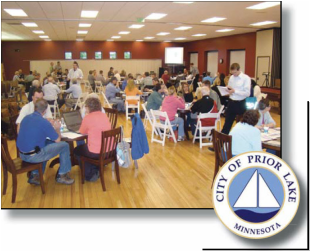City of Prior Lake - 2030 Vision and Strategic Plan
|
Just under 100 residents, elected officials, and city department managers gathered to evaluate the potential short and long-term consequences of the major changes facing the city since their previous strategic plan was developed. The exploration resulted in 37 completed "arcs" with 1176 specific implications.
Mayor Mike Myser: "The biggest thing that struck me was the Implications Wheel. This is a valuable tool for homeowners, businesses, etc. to think through all of the implications to learn consequences. " |
Details of the Center
The current 2030 Strategic Vision was based on several key assumptions that are no longer valid. These assumptions and additional facts include:
1. A build-out (commercial and residential) of 100% by 2030 which now is more likely to be 2050.
2. A population of 40,000. Population in 2000 was 15,917; 2005 estimated population was 21,395; 2010 projected population was 26,500. Census shows 22,796 in 2010.
3. Growth rate of 1 to 2% versus anticipated 4% growth rate per year.
4. Growth includes anticipated -- orderly annexation of 3000 acres from Spring Lake Township by 2024. Currently, progress is slower than anticipated with – acres not yet annexed than called for by the agreement.
5. Infrastructure, City Hall, Police Station, Sewer was constructed assuming faster rates of growth.
6. Park land not developed -- underutilized because of slower growth -- 64 acres( Pike Lake and Spring Lake Park).
7. Major collector streets, i.e., Fish Point Road, Carriage Hills, Stemmer Ridge Road, North Berens Road, Turner Drive, Sunray Boulevard, not connected until development occurs.
8. Reduced state funding, intergovernmental transfers -- 50% cut in 2008, 100% cut in 2009, 100% cut in 2010 (258K).
9. Expansion of multifamily housing from 2002-2006: 7 buildings with at total of 522 units; 395 units are dedicated senior housing.
10. Reduction of building permits. (See attached information for 2001-2010)
11. Bloomington Ferry Bridge substantially increased development of Scott County.
12. SCALE and the Scott County are strongly encouraging the State Legislature to repair the approaches or add new river crossings to reduce or eliminate the economic consequences of flooding events.
13. Valuation of new single family homes is lower than previous years. (See attached information for 2001-2010)
14. Gas prices have doubled since 2005.
15. Numerous residential and commercial developments have stalled at community gateways including: CR42 and CR18: Summit Preserve; CR42 and CR21: Jeffers Waterfront; TH13 and CR12 : Hickory Shores and CR42 and Pike Lake: Fountain Hills
16. Increase in commercial vacancies.
17. SMSC continues to expand non-gaming commercial facilities: (Natural Food Store, Amphitheater, and Credit Union)
18. SMSC employs @3800 -- down from @5000 in 2009.
19. 600 Prior Lake residents employed by SMSC.
20. SMSC continues to provide -- voluntarily -- $380K to the city but increasingly uncertain funding.
21. Partnership with SMSC that provides youth programs (Playworks), recreational facilities (Dakota Sport and Fitness and the Ice Arenas).
22. Spring Lake and Upper Prior Lake continue to be impaired waters.
23. Kindergarten enrollment (public) is declining -- after years of rapid growth.
24. School districts are experiencing cutbacks in state funding.
25. Pressure to expand school facilities has been temporarily relieved.
26. Crossroads commercial area completed in 2009.
27. Zoning restrictions relaxed for more commercial friendly development.
28. Economic development authority reformulated to include three business people and is now active.
29. Hwy 21 extension to Hwy 169 to be completed in fall, 2011. Traffic volumes at 21/13 estimated to increase from 10,000 ADT to 27,000 ADT.
30. Increased traffic in downtown because of earlier growth and CR 21 connection.
31. No responses to two RFP's for downtown redevelopment.
32. Reductions in city staff and services, since 2007.
33. Farmer's Market continues to bring an estimated 500 to 800 shoppers downtown on Saturdays.
34. Upcoming decision on realignment of 21 through downtown likely in June or July.
35. Metropolitan area numbers... (See attached spreadsheet for Metro, Scott County and Prior Lake comparison)
36. 2005 Comprehensive Plan reduced R3 zone from 600 to 60 acres and 40 units per acre to 30 units per acre. The impact is 24,000 dwellings to 1800 ( at 2.0 persons per DU) dwelling units or new potential population from 48,000 to 8600 persons.
1. A build-out (commercial and residential) of 100% by 2030 which now is more likely to be 2050.
2. A population of 40,000. Population in 2000 was 15,917; 2005 estimated population was 21,395; 2010 projected population was 26,500. Census shows 22,796 in 2010.
3. Growth rate of 1 to 2% versus anticipated 4% growth rate per year.
4. Growth includes anticipated -- orderly annexation of 3000 acres from Spring Lake Township by 2024. Currently, progress is slower than anticipated with – acres not yet annexed than called for by the agreement.
5. Infrastructure, City Hall, Police Station, Sewer was constructed assuming faster rates of growth.
6. Park land not developed -- underutilized because of slower growth -- 64 acres( Pike Lake and Spring Lake Park).
7. Major collector streets, i.e., Fish Point Road, Carriage Hills, Stemmer Ridge Road, North Berens Road, Turner Drive, Sunray Boulevard, not connected until development occurs.
8. Reduced state funding, intergovernmental transfers -- 50% cut in 2008, 100% cut in 2009, 100% cut in 2010 (258K).
9. Expansion of multifamily housing from 2002-2006: 7 buildings with at total of 522 units; 395 units are dedicated senior housing.
10. Reduction of building permits. (See attached information for 2001-2010)
11. Bloomington Ferry Bridge substantially increased development of Scott County.
12. SCALE and the Scott County are strongly encouraging the State Legislature to repair the approaches or add new river crossings to reduce or eliminate the economic consequences of flooding events.
13. Valuation of new single family homes is lower than previous years. (See attached information for 2001-2010)
14. Gas prices have doubled since 2005.
15. Numerous residential and commercial developments have stalled at community gateways including: CR42 and CR18: Summit Preserve; CR42 and CR21: Jeffers Waterfront; TH13 and CR12 : Hickory Shores and CR42 and Pike Lake: Fountain Hills
16. Increase in commercial vacancies.
17. SMSC continues to expand non-gaming commercial facilities: (Natural Food Store, Amphitheater, and Credit Union)
18. SMSC employs @3800 -- down from @5000 in 2009.
19. 600 Prior Lake residents employed by SMSC.
20. SMSC continues to provide -- voluntarily -- $380K to the city but increasingly uncertain funding.
21. Partnership with SMSC that provides youth programs (Playworks), recreational facilities (Dakota Sport and Fitness and the Ice Arenas).
22. Spring Lake and Upper Prior Lake continue to be impaired waters.
23. Kindergarten enrollment (public) is declining -- after years of rapid growth.
24. School districts are experiencing cutbacks in state funding.
25. Pressure to expand school facilities has been temporarily relieved.
26. Crossroads commercial area completed in 2009.
27. Zoning restrictions relaxed for more commercial friendly development.
28. Economic development authority reformulated to include three business people and is now active.
29. Hwy 21 extension to Hwy 169 to be completed in fall, 2011. Traffic volumes at 21/13 estimated to increase from 10,000 ADT to 27,000 ADT.
30. Increased traffic in downtown because of earlier growth and CR 21 connection.
31. No responses to two RFP's for downtown redevelopment.
32. Reductions in city staff and services, since 2007.
33. Farmer's Market continues to bring an estimated 500 to 800 shoppers downtown on Saturdays.
34. Upcoming decision on realignment of 21 through downtown likely in June or July.
35. Metropolitan area numbers... (See attached spreadsheet for Metro, Scott County and Prior Lake comparison)
36. 2005 Comprehensive Plan reduced R3 zone from 600 to 60 acres and 40 units per acre to 30 units per acre. The impact is 24,000 dwellings to 1800 ( at 2.0 persons per DU) dwelling units or new potential population from 48,000 to 8600 persons.

